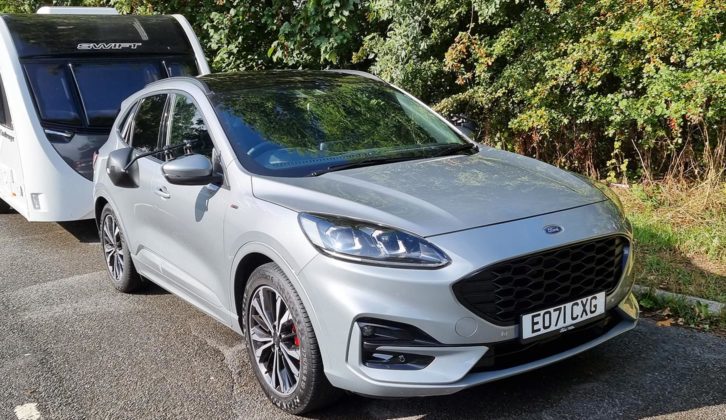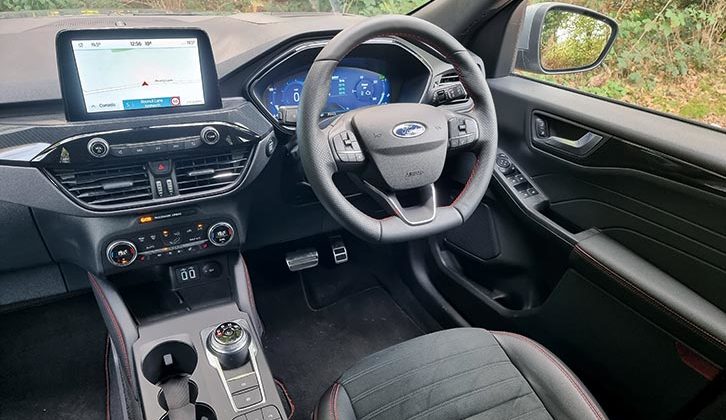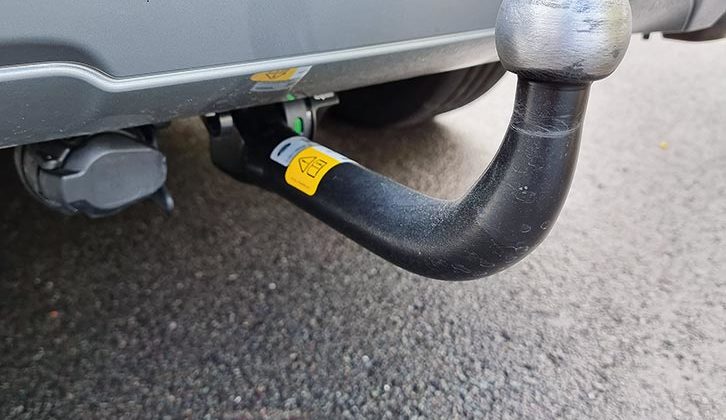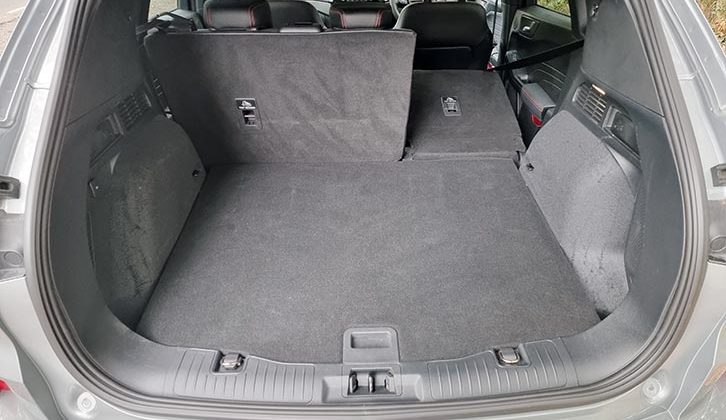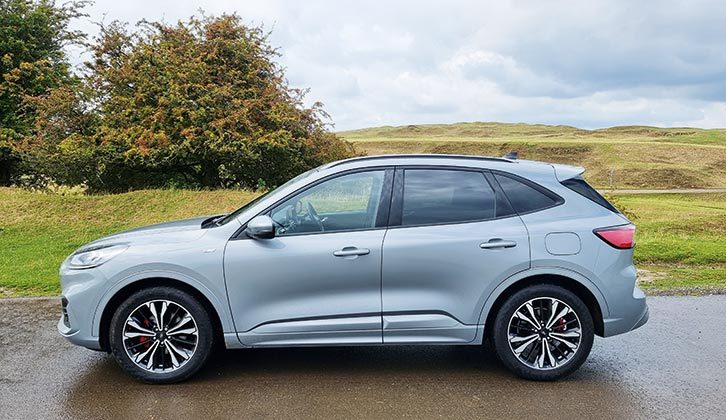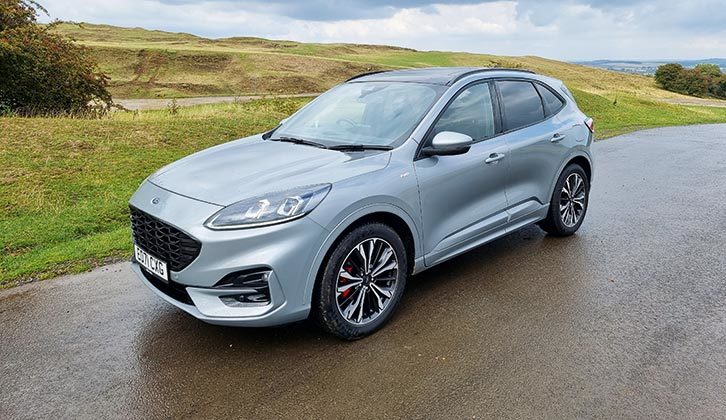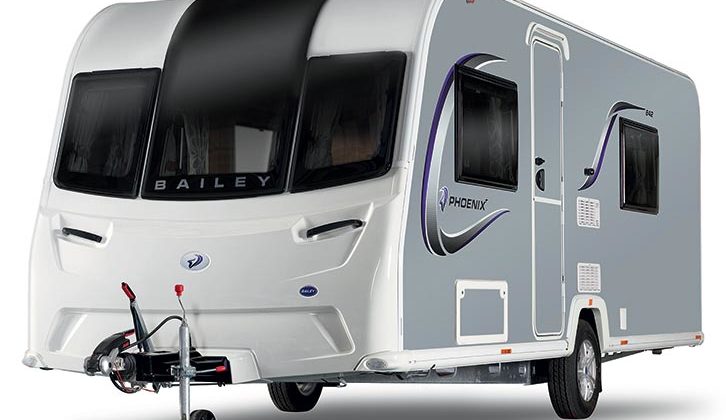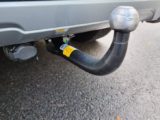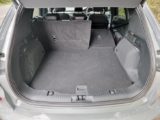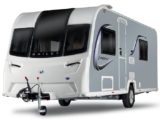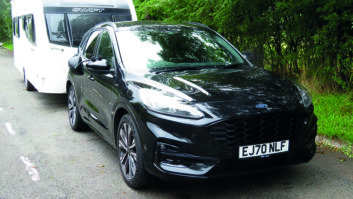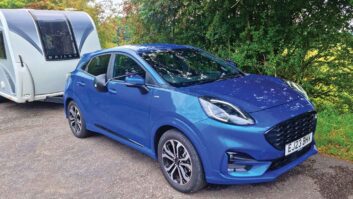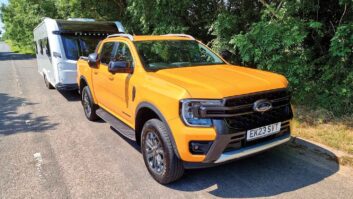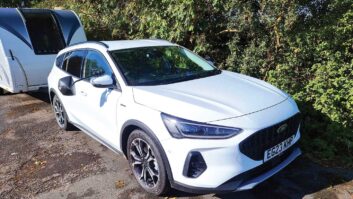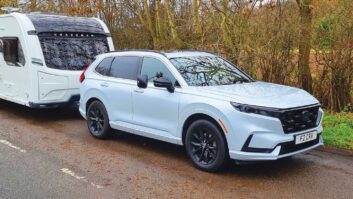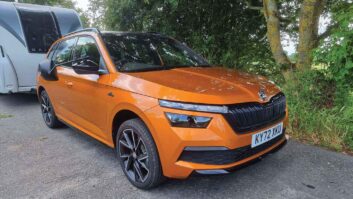We’ve towed with the Kuga already, but in plug-in hybrid tow car form. When we drove that vehicle, it was somewhat hampered by the 1200kg towing limit, although that has now been upgraded to 1500kg. The full hybrid is lighter and cheaper, but has a 1600kg limit. It has a much smaller battery that recharges without being plugged in, using energy that would otherwise be lost in coasting or braking. We’ve been driving the high-spec ST-Line X Edition, with a list price of £38,045, the Ford Kuga 2.5 FHEV 190PS ST-Line X Edition FWD Auto.
What are we looking for?
Ford offers petrol, plug-in hybrid and full-hybrid powertrains to Kuga buyers. Is the full hybrid Ford Kuga the pick of the bunch? And how well does the Ford compare with talented rivals such as the Kia Sportage and the Škoda Karoq?
Towing ability of the Ford Kuga 2.5 FHEV 190PS ST-Line X Edition FWD Auto
Although the full-hybrid Ford Kuga is lighter than the plug-in, it still weighs a healthy 1701kg. That’s broadly in line with the weight of similar rivals from the likes of Hyundai
and Kia, and means a wide range of family caravans make sensible matches.
As most caravanners know, the two big caravan clubs recommend towing tourers weighing no more than 85% of the tow car’s kerbweight. We matched the Ford to a Swift Challenger 560 with a MiRO of 1394kg, making it an 82% match for the Kuga without any luggage inside.
Even with an extra 1.4 tonnes behind it, the Kuga feels quite brisk from a standing start. Although the 2.5-litre petrol engine has just 148lb ft of torque, the electric motor takes up the slack at low speeds, and both Kuga and caravan accelerate with real purpose.
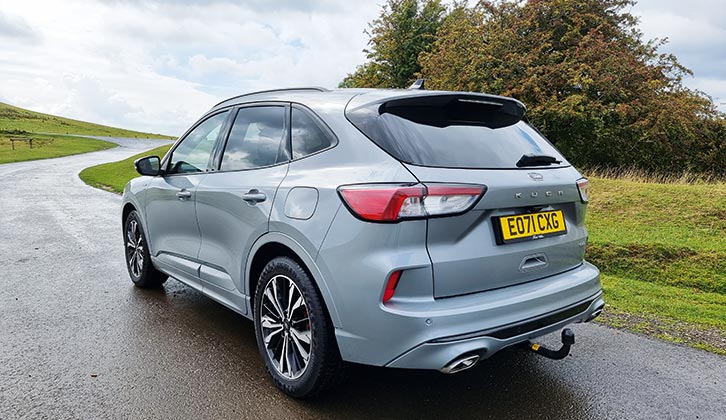
To some extent, though, the hybrid flatters to deceive. Accelerate hard on an uphill motorway sliproad and the performance isn’t so strong, with the petrol engine working hard and sounding rather strained. It certainly doesn’t feel as punchy between 40mph and 60mph as the Škoda Karoq diesel we towed with in issue 458.
It will hold speed happily enough, though, and once cruising at an even pace, engine noise settles into the background.
Sometimes it disappears completely, as the engine switches off and the electric motor manages alone. The trip computer shows you how much of your journey is completed using electricity, and we were surprised and impressed to discover the Kuga covered around 14% of its towing mileage on battery power.
The Ford’s stability is generally very good, as the firmly controlled suspension doesn’t give the caravan much say over where the outfit is heading. There were some slight movements from the van in passing lorries and coaches, but nothing to worry about.
Hill starts in the dry are straightforward. The electronic parking brake stops both car and caravan rolling backwards and releases smoothly, although there was a brief moment of wheelspin.
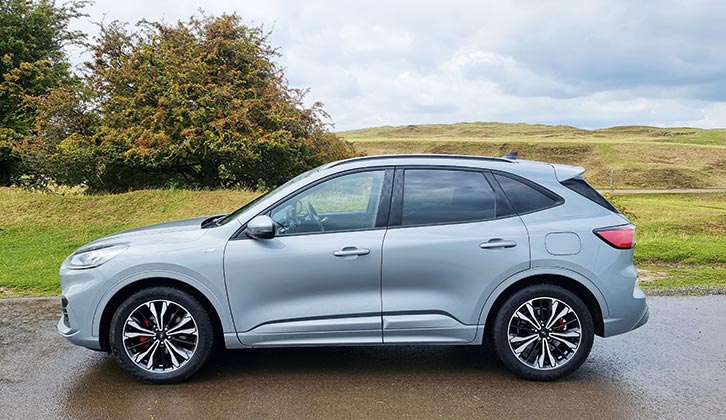
It does make you wonder if the Kuga would have trouble pulling away in wet weather. Unlike the full-hybrid Hyundai Tucson and Kia Sportage, there is no 4×4 version of the Kuga hybrid. If you want Ford’s family SUV with four-wheel drive, you’ll need a diesel, although you’ll have to look for a used example.
You will need to be careful hitching and unhitching at a campsite. The Kuga is very keen to get moving when you lift your foot from the brake while in gear, so you really need to concentrate to reverse slowly. Switching to ‘Eco’ rather than ‘Normal’ mode will make it a little less responsive and more willing to creep steadily.
The towball is well clear of the bumper, but the 13-pin electrics are tucked a long way underneath. You have to reach back a fair distance to tug the socket into place and slot the plug home.
Solo driving of the Ford Kuga 2.5 FHEV 190PS ST-Line X Edition FWD Auto
The Kuga is an enjoyable hybrid tow car to drive every day, although the suspension will probably be too firm for some tastes.
Ford has given the ST-Line X Edition sports suspension. You feel the benefit on country roads, where the Kuga is controlled over bumps and agile around corners.
It’s not so great when you’re pootling around town, as the suspension thumps into potholes and fidgets if the surface is less than perfect. It improves at motorway speeds and on A-roads, although there is a lot of road noise. For a more forgiving ride, you might prefer the Škoda Karoq or the Volkswagen Tiguan.
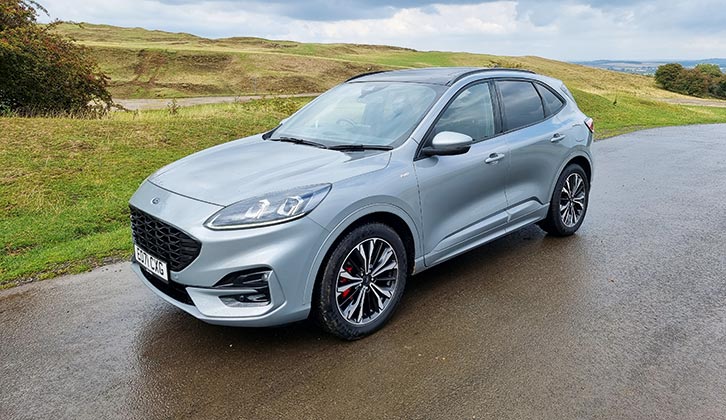
Just as when towing, the Kuga feels lively from a standing start thanks to the instant response from the electric motor. As speeds rise, it’s brisk rather than quick. That’s not a complaint, more an observation that its spirited response from low speeds leads you to expect more of the same.
The steering is light enough for easy parking, but switch to the sportiest of the car’s drive modes and it weights up nicely.
Space and practicality
The Kuga is a practical car, so long as you can live with a boot that isn’t as spacious as that of some rival vehicles.
Drivers of most shapes and sizes should be able to find a comfortable driving position, with a reasonable range of adjustment to both seat and steering wheel. However, really tall drivers might find they wish for just another couple of centimetres of legroom.
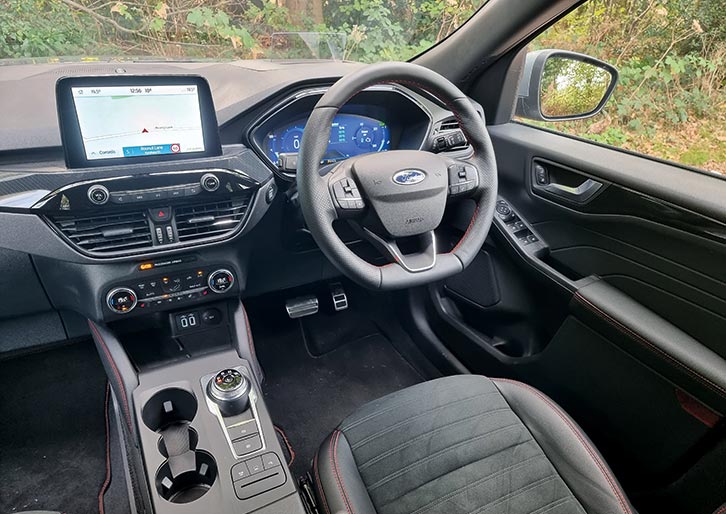
Whatever your height, we doubt you’ll be bowled over by the Kuga’s finish. It’s neat enough and solidly put together, but the plastics look and feel cheap for a car with a price tag nudging towards £40,000.
Every specification of Kuga comes with a Sync 3 eight-inch touchscreen infotainment system. This looks a bit basic compared with slicker systems in rivals from Hyundai or Kia, but it’s reasonably easy to get the hang of. Thankfully there are separate air-con controls, so you don’t need to use the touchscreen to tweak the cabin temperature or make alterations to the fan speed.
The back of the car has lots of legroom, and the headroom is pretty good too, even in the ST-Line X Edition models, which come with a standard-fit panoramic sunroof.
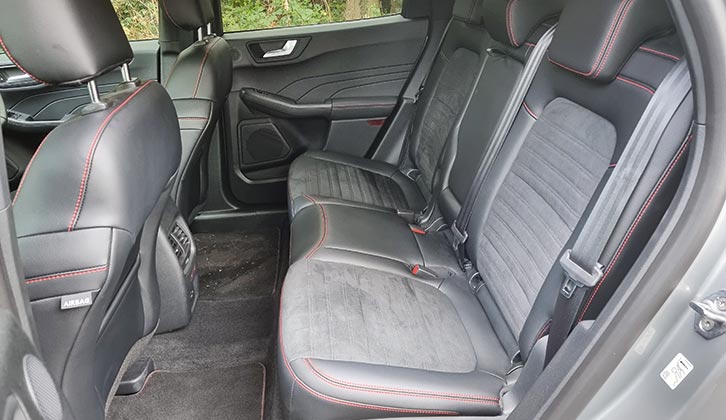
Air vents between the front seats should keep those in the back comfortably cool.
The Kuga falls down a little when it comes to boot space. With the luggage cover in place, there’s 475 litres, significantly less than the 587 litres of room in the Kia Sportage’s boot.
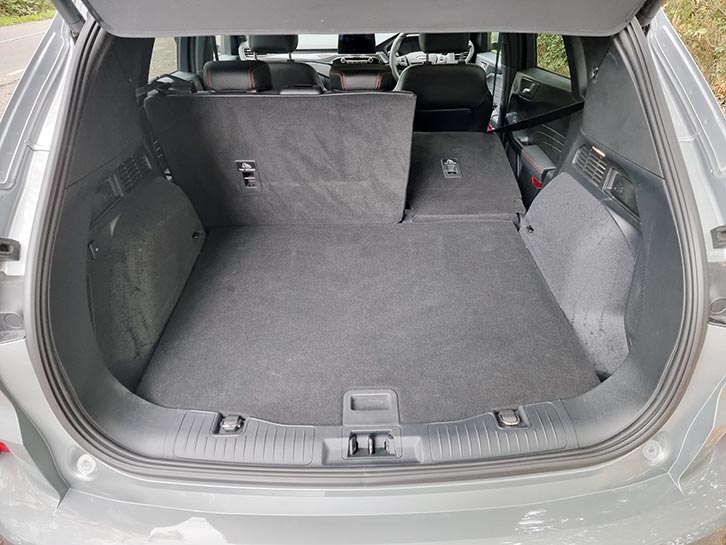
On the other hand, you can make more space for bags by sliding the Ford’s rear seats forward. There’s lots of legroom to start with, so it’s not going to be much of a hardship for those in the back seats to give up just a few centimetres so you can avoid travelling light.
There’s no load lip to cause back strain while you’re loading up the boot, and if the rear seats are empty, levers on either side of the tailgate will quickly drop the back seats down to provide up to 1534 litres of space.
Buying and owning
Not so long ago, we would have thought the Kuga expensive at £38,000, but the price of new cars has increased at pace over recent years. Compared with its rivals, the Kuga is good value.
Haggle a bit and the asking price should drop to around £36,346, according to research by What Car? magazine.
Fuel economy is excellent, something we always look for when we’re looking for the best tow car. We saw better than 50mpg in solo drives, and a remarkable 30.7mpg while towing. That compares with 25.5mpg when we tested the Kia Sportage hybrid towing a similar van.
ST-Line X models are well equipped. Heated front and rear seats, a heated steering wheel, digital instruments, sat nav and dual-zone climate control are among the highlights.
Safety standards are very high – the Kuga has a five-star rating from Euro NCAP. The driver assistance pack adds even more safety kit and driver aids for an extra £1100.
After three years and 36,000 miles, What Car? predicts the Kuga will be worth 53% of its original price, a solid return for a car from a mainstream brand.
The perfect partner
With 85% of the Kuga’s kerbweight at 1446kg, you can safely tow a Bailey Phoenix+ 640.
Verdict
The full-hybrid Kuga has a great deal going for it. Fuel economy is outstanding, to the extent that we’re not surprised Ford has culled the diesel from the range. Usually we find hybrids to be economical around town, but less so on motorway journeys or while towing. That’s not the case with the Kuga, which sips fuel on long drives as well, with or without a caravan.
It’s a good tow car, too. The Kuga is reassuringly stable, and while not as quick as it first seems, the FHEV has enough muscle to handle regular towing.
It could be easier to manoeuvre at low speeds, and it’s a shame there’s no 4×4. That counts against it as a four-season tow car and puts it at a disadvantage compared with the Hyundai Tucson and Kia Sportage.
In everyday driving, the Kuga is enjoyable to drive, with brisk performance and composed cornering. The ride is on the firm side around town, but the suspension works well at higher speeds.
Inside, there’s plenty of room for people, but not so much space for luggage. Ideally, we’d like a smarter cabin finish as well as more room for bags. The clever rear seats do go some way to make up for that, allowing you to trade rear legroom for more luggage space.
So, which is the better Kuga hybrid? The full hybrid has a 100kg higher towing limit than the plug-in, and is £850 cheaper. But if you can recharge each night, the plug-in costs less to run. The choice comes down to the type of trips you make and whether you can fit a home charger.
- Price: £38,045
- What Car? Target Price: £36,346
- Retained value after three years: 53%
- Kerbweight: 1701kg
- 85% of kerbweight: 1446kg
- Gross vehicle weight: 2215kg
- Max towing limit: 1600kg
- Gross train weight: 3815kg
- Towball limit: 100kg
- Price of towball and electrics: £625
- Boot size min/max: 475/1534 litres
- Payload: 514kg
- Test conditions: Dry
- Engine size: 2498cc
- Power (hp)/rpm: 190/5500
- Torque (lb ft)/rpm: 148/4500
- Official combined economy: 48.7-51.4mpg
- Towing economy: 30.7mpg
- CO2 emissions: 125-133g/km
- First year car tax: £180
- Second year car tax £155
- Insurance group 20E
Or you could try…
Kia Sportage 1.6 T-GDi HEV
- Price: From £34,000
A stable tow car, with more boot space and a better finish than the Ford Kuga.
Skoda Karoq 2.0 TDI 150PS 4×4 DSG
- Price: From £35,080
The Skoda is extremely practical and makes a very stable tow car.
Used Audi Q5 40 TDI S line
- 19-plate, 66,000 miles
- Price: £29,990
Strong build and performance, and unshakeable stability.
Used Lexus RX450h
- 14-plate, 44,000 miles
- Price: £20,990
Luxury on a budget, and superbly reliable.
If you’ve enjoyed reading this article, why not get the latest news, reviews and features delivered direct to your door or inbox every month. Take advantage of our brilliant Practical Caravan magazine SUBSCRIBERS’ OFFER and SIGN UP TO OUR NEWSLETTER for regular weekly updates on all things caravan related.
Technical Specifications
| Engine Size | 2498 cc |
| Kerbweight | 1701 kg |
| 85% KW | 1446 kg |
| Towball Limit | 100 kg |
| Maximum Towing Limit | 1600 kg |
| Power | 190 bhp |
| Torque | 148 lb ft |
| Offical MPG | 48.7-51.4 mpg |
| Towing MPG | 30.7 mpg |
| CO₂ | 125-133 g/km |
